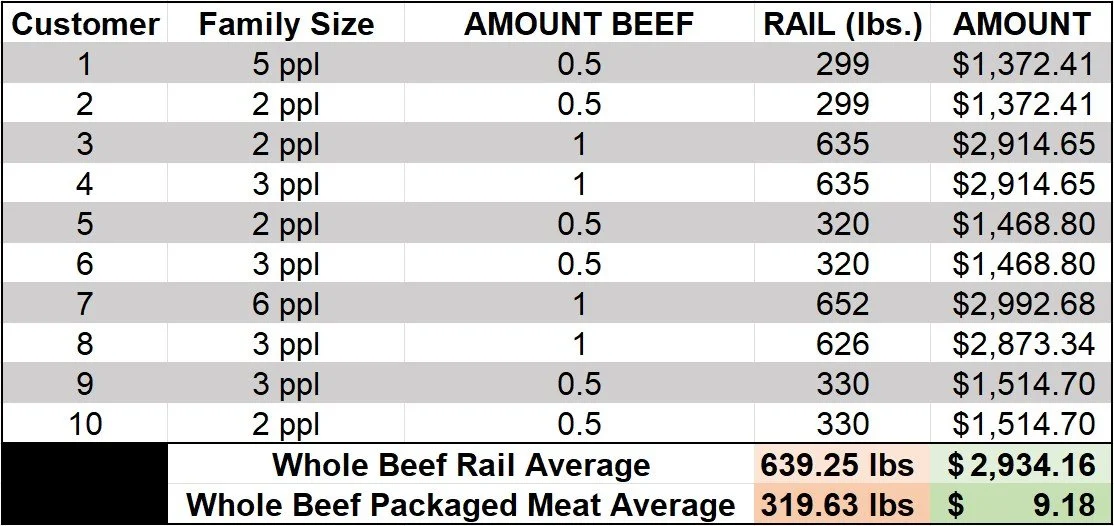How Much Meat is in a Custom Beef Order?
A Comprehensive Guide to Purchasing and Understanding Bulk Beef Orders
Introduction
Purchasing beef in bulk through a custom order, sometimes known as buying a side, half, or whole beef—has become increasingly popular among families, food enthusiasts, and those looking to support local agriculture. However, for many first-time buyers, one pressing question stands out: How much meat does a custom beef order provide?
This guide will walk you through the process, from live animal to freezer, explain the terminology, discuss variables that affect yield, and help you understand what to expect when you invest in a custom beef order.
Understanding Custom Beef Orders
Before diving into the specifics of meat yield, it is important to clarify what a custom beef order typically involves.
Whole Beef: You are purchasing the entire animal, which allows for the greatest flexibility in cutting options.
Half Beef (Side): You receive half of the animal, divided equally between the left and right sides.
Quarter Beef: Some processors often split halves or mixed quarters, giving you a proportional share of both front and back cuts of one side.
Each option allows for customization of cuts, thickness, quantities of ground beef versus steaks or roasts, and packaging preferences.
From Live Weight to Freezer: The Beef Breakdown
The journey from farm or ranch to freezer involves several stages, each with its own terminology and impact on the final amount of meat you receive. The three most common weights you will encounter are:
Live Weight (aka On-the-Hoof): The weight of the animal when it is alive.
Hanging Weight (aka Rail Weight): The weight of the carcass after the initial slaughter process, with the hide, head, hooves, blood, and internal organs removed. This is the figure typically used by processors for billing.
Packaged Weight: The most ‘expensive’ per pound weight but will only be based on the meat that is packaged after the butcher processes and ensures everything is grill ready.
I Understand the Weights…How Much Meat Do I Receive?
Figure approximately 30% of the live weight. We provide that as a conservative estimate for a packaged order.
For example, a steer with a live weight of 1,000 pounds may have a hanging weight of around 600 pounds, and a final yield of roughly 300 pounds of packaged meat.
The easiest way to roughly calculate the weight is to take whatever the live weight is and multiply it by 30%. That will be your approximate cut-and-wrapped meat weight.
Our 2024 examples of approximately 1,000-pound grain-finished steers are outlined below for some quantitative data.
Figure 1 outlines the hanging weight of each steer and its associated final cost from the $4.59 per pound.
Figure 2 then breaks down the beef order amount by family size and their final payment. At the bottom of Figure 2 you find the average hanging weight of all steers as well as the average packaged meat with the final calculated cost per pound of packaged meat based on the amount sold at the $4.59 hanging weight price.
Figure 1
Figure 2
Conclusion
The amount of meat you receive from a custom order is not always as large as you may expect.
If you know the live weight of a butcher animal and multiply it by 30% you will have an approximate take-home amount calculated. While this simple figuring may seem low, it is a general approximation and will usually supply a family for an entire year.
Keep in mind, final yield amounts can vary based on cut requests also. If you choose to make certain cuts, such as spareribs for example, into burger you will reduce yield weight due to the removal of bone. Additionally, if you choose to have 80/20 burger you may increase your yield weight slightly because of the added tallow compared to an 85/15 or 90/10 burger mixture.
This bulk purchase usually provides most meals for a household annually, but it does not guarantee you will not return to the store on occasion for special cuts. A great example is if your order requires all rib steaks from the rib area. This decision would require you to purchase a Prime Rib roast for a celebratory dinner of Prime Rib for a large gathering.
If you would like additional information from your producer to make a more informed decision, just ask! Usually, they will have records from previous years to provide some data, which will help with your research.

